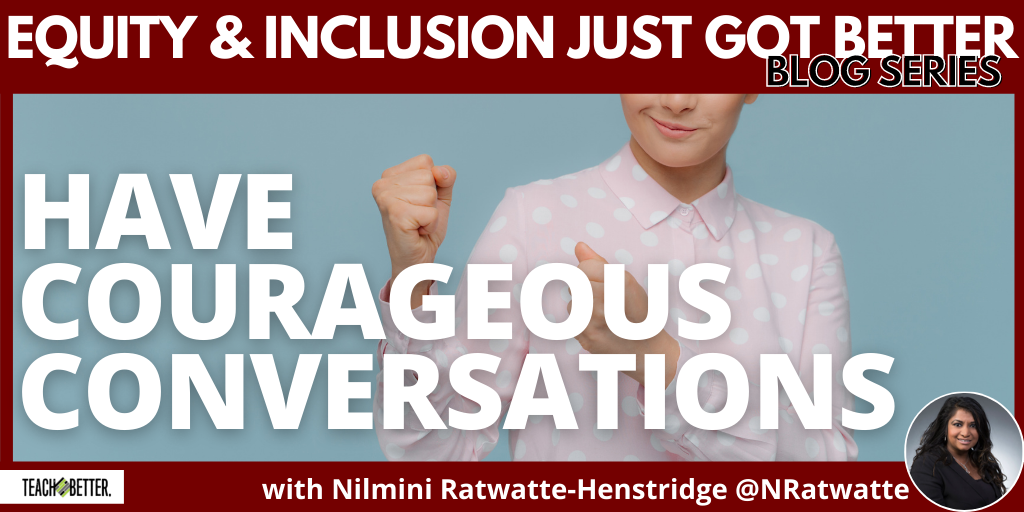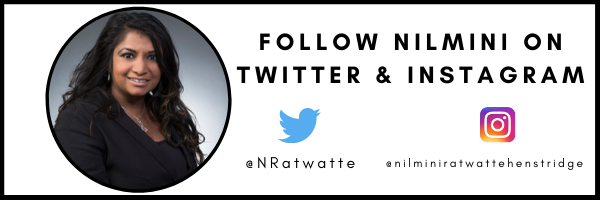TL;DR:
- Advocate for equity and inclusion by being brave and honest.
- Know you can’t control the reaction of others, but you can control your actions to create positive spaces.
- Don’t let the voice of someone be silenced. It’s not ok, so speak up.
- This post shares 4 steps to having courageous conversations.
Journaling/Reflection Questions for Courageous Conversations:
- Can you plan out one opportunity to have a courageous conversation with your students? (Now, make it a SMART Goal for yourself each month.)

In Ontario, Canada, it’s beautiful. The weather is warm, and the breeze is calming with only sounds of nature around. This is me on summer holidays, as I blog and connect with you. Teaching and learning is invaluable and I love summer vacation reflective times.
- How would you ensure that it is a safe space for all students?
- How would you make space for an opportunity to ensure that you and your class would speak up and advocate for someone else when it comes to equity and inclusion?
July is summer vacation. I love cooking and spending time relaxing with family, friends, and making awesome meals. I hope you get to enjoy reflecting as you read this blog this summer!
Here is a frame of mind on how to work on having successful and courageous conversations about diversity—my recipe for your classroom. Choose how you will adapt it and practice working through the steps. Remember, it is not the only method to making this amazing meal to start courageous conversations…you may find a different path with the same ideas.
As an Appetizer – First consider:
What is a “courageous conversation”?
- Be brave to have the conversations that sit uncomfortably with you, that make you feel that knot at the bottom on your stomach. Those are the conversations that will help you grow as an educator by creating safe spaces.
- Reflect. It’s important in the learning journey to reflect about how you are feeling, why you are feeling what you are feeling, and where the root of those feelings comes from.
The Main Course – Then discuss:
What does “bias” mean?
We can all have opinions that are biased, or points of views that are unjust when it comes to certain topics. Remember no one is perfect. We are all flawed and have biases that we carry with us. Sometimes they are evident and other times we have to be more reflective and observe our reactions. We should value our knowledge and lived experiences as we address overcoming bias points of views.
What is race?
Race is a socially constructed concept. We are all human and have differences depending on where we live, our geographical location in the world. Our race is Human. But in a socially constructed world, we have given hierarchy to lighter skin colours and organized social structures. Therefore, given the opportunity for social and structural institutions such as the school systems, we work in to be regulating with that colonial frame of mind.
Racism
Racism is discrimination or biases that others hold to believe that one skin colour is better than another from the colonial mindset. It is taught, passed down from generations. This also means it can be re-taught and unlearned. Therefore, it is important to recognize the colour of our skin, to hear their stories, obstacles, and challenges from lived experiences, which is a part of an individual’s identity.
It is not ok to be biased, be racist, or experience racism. It is a privilege to learn and teach about it rather than actually experiencing it.
When It’s Dessert:
Be prepared to embrace “differences.”
We are different from each other; we have to be comfortable with that concept when we do work with equity. Build our practise by being inclusive. Don’t look for things you have in common, but embrace that we are different.
Whenever you get to listen to a story, really make the time to hear it carefully. You never know the connections you may build, the friendships you will develop, and what lessons can be passed down to you. Maybe you can impact global changes in a positive manner as global educators.
Race relations in the diverse world that we live in maintains world peace.
Research on diversity at Ryerson University names the following three things we can do as an individual as we hold ourselves accountable in advocating for equity.
- Find or be a mentor.
- Self-promote or sponsor.
- Challenge unfair practices, microaggressions, and stereotypes or policies.
That Midnight Snack on a Summer Night:
Finally, connect it to invaluable discussions in our classrooms…
The technique of having discussions through technology helps us engage learning, make connections, and personalize curriculum expectations.
The technique of having discussions through technology helps us engage learning, make connections, and personalize curriculum expectations. Click To Tweet- Pixton: I love the ability to make cartoon stories with classes. The program is user-friendly for students, even in primary grades. Also, it engages learners. The program allows you to create your own student profiles so individual students can do their own work, being creative at their own pace.
- Scratch: I love the coding embedded storytelling that can happen as we develop a better understanding of computer programing. I have never had more fun marking than working with Scratch with student creations.
- Stop Motion Animation: You can download this in the App store. It is one of my favourite applications to work with as I go over the basic structures of a story. I animate it to life using Claymation and Lego Animation when teaching in a digital classroom.

Courageous Conversations
A Mahatma Gandhi quote that I always look up to is: “In a gentle way, you can shake the world.” I challenge you to find your voice and shake our beautiful world gently to make it a better one, through educational lesson ideas that inspire, elevate understanding, and encourage daily. Inspire each other as educators and aspire to work together to elevate global voices of unity, peace, and prosperity.
Yours in Education,
Nilmini
References
Dioangelo, Robin. 2018. “White Fragility”.
Eakins, Dr. Sheldon L. “Teaching Through A Culturally Diverse Lens”. Leading Equity Center.
“Diversity in Schools must include curriculum”. The Century Foundation.
https://tcf.org/content/commentary/diversity-schools-must-include-curriculum/
Ratwatte-Henstridge, Delani Nilmini. Teach Better Chat: 2021 June 24th. “Let’s Talk Equity Tonight!”
Ryerson University, Canada. Ted Rogers School of Management’s Diversity Institute.
https://www.ryerson.ca/diversity/Presentations/DL2020_Slides.pdf
About Nilmini Ratwatte-Henstridge
Nilmini Ratwatte-Henstridge teaches in Brampton, Ontario, Canada. She was born in Sri Lanka and immigrated to Canada with her family. As an Elementary School Teacher who is passionate about Equity, Social Justice, and Human Rights in education, she enjoys teaching the younger generation to be global-minded citizens.
Discovering the world by connecting with others is an opportunity that we have today in our society today and she loves meeting new people! She is always learning while traveling to understand the inter-connectedness of this beautiful earth we live in! Nilmini LOVES cooking great meals, watching movies, and the latest fashion trends! Family and friends are close to her heart as she looks forward to balancing social media and navigating professional learning communities in education to network globally this year!



